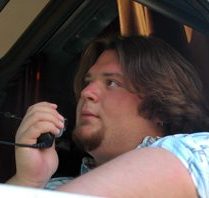The 2014 Federal Motor Carrier Safety Administration’s Large Truck Crash Causation Study found that 13% of truck drivers were tired when they crashed. Crashes, even if they’re minor, are costly. Loads arrive late, and repairs and property damage are additional expenses. How can you lower the risk of driver fatigue?
Avoid Beverages and Medications That Make You Sleepy
Before you have a beer, glass of wine, or cocktail, remember that alcohol can make you sleepy. You also want to watch any medications you’re taking. Your allergies may be irritating, but many allergy medications contain ingredients that cause drowsiness. You do not want to take these medications while you’re on the road.
Bring a Companion
Are you allowed to have a companion with you on a long route? If you can bring a dog, you’ll have someone to talk to, and you also have to think about the dog’s need for a break. Some companies allow drivers to bring a pet or two. You may need to pay a damage deposit, just in case, but it’s often refundable if you stop driving for that company.
Abide by the rules. If you’re supposed to keep the dog or cat leashed or harnessed when the truck moves, follow that rule. It’s safest for the pet, too. Some companies may require you to choose a non-bully breed. Most ask for a copy of rabies and other vaccination records before your pet joins you.
Use Caffeinated Beverages to Your Advantage
Studies show that drinking two caffeinated beverages like coffee and then pulling over for a 20-minute nap can help drivers become more alert. Don’t rely on this trick all of the time. But, it’s okay to energize with caffeine now and then.
Do not just have two cups of coffee and try to push through. You may feel more alert, but it’s a short-term solution that can lead to “microsleep.” Microsleep is a very quick moment of sleep that lasts just a few seconds. You can travel more than 300 feet in those three to five seconds if you’re traveling at interstate speeds.
Crank Up a Podcast or Music
Crank up music or a podcast that grabs your attention. You don’t want to listen to something that is soothing and makes you sleepy. Turn up the volume so that it’s not just background noise that relaxes you.
Drink Plenty of Water
Stay hydrated. Dehydration can make you feel tired, even if you’ve gotten enough sleep. The average woman should drink approximately two liters of water per day, while a man needs around three. If you’re active or sweating profusely due to the heat, you need to increase your water intake.
Eat a Balanced Diet
Eat a balanced diet and avoid the carb crashes that can make you feel drowsy. Instead of having a burger and fries, have a burger and a salad or bowl of homemade soup. Skip sugary snacks and have some roasted almonds instead. Too many heavy carbs quickly boost your blood sugar levels. As the sugar levels settle back down, you’ll feel sleepy and want to take a nap.
Stop and Walk Around Every Two Hours
Stop every couple of hours to walk around and use the bathroom. Stretching out will help you stay awake, and you’re also able to drink plenty of water by making sure you’re emptying out regularly.
Keep the Air Moving
Open a window and keep the air within the cab moving around. Fresh air will help you feel more awake and alert. If you close everything up and turn on a heater, the humid, warm air may trigger a sleep response that has you feeling drowsy.
Plan to Start Driving When You’re Normally Awake
If you tend to sleep from 10 p.m. to 5 a.m., it’s not ideal to start driving at 3 a.m. Your body is used to being asleep at that hour. Start your long trips at the hour you usually are awake and starting your day. As you travel, keep your usual sleep patterns in mind. If you’re not at your destination by 10 p.m., it’s an excellent time to find a hotel or rest stop and stay there for the rest of the evening. Start the next leg of your trip in the morning.
Nap When You Can
When you stop for a meal or have reached your required 30-minute break after driving 8 hours, try to time it so that you can fit in a 15 to 20-minute nap. A quick nap helps refresh your body. When your alarm goes off, get up and walk around outside to become fully awake before you start driving again.
Stick to a Schedule
Plan and stick to a schedule. You don’t want to fall asleep on the job, but you also have to arrive at your destination by a particular hour. Stick to a schedule to ensure you don’t fall way behind. If you’re traveling across the country, you’ll have to follow the rules set forth by the Federal Motor Carrier Safety Administration.
Per FMCSA rules, you are allowed to drive a maximum of 11 hours if you’ve been off duty for at least 10 hours. Once you’ve driven for 8 hours without taking a break, you are required to take a half-hour break. An off-duty period requires at least 7 hours spent in the sleeper berth in your cab and another 2 or more hours either inside or outside of that sleeper berth. The hours need to total at least 10 hours off. Finally, you’re never allowed to drive more than 60 hours in 7 consecutive days on duty or 70 hours in 8 consecutive days.
When you’re planning your daily schedule, you need to keep those requirements in mind. Check the states you’re driving in, as some have state rules that are stricter than the federal rules.
Plan Your Routes Accordingly
The best way to stay awake on the road is by carefully planning your route. Whether you schedule routes for your drivers or you have a scheduler doing it for you, you want to plan routes that make sense. Increase profits by eliminating empty legs and by choosing the destinations that eliminate the risk of falling asleep at the wheel.
Saint John Capital offers a load board you can access on your phone or tablet. You gain total control over the jobs you take, making it easy to pick a driver who is already in that area or heading to that area. Sign up for our 60-day free trial for your Android or iOS device.















